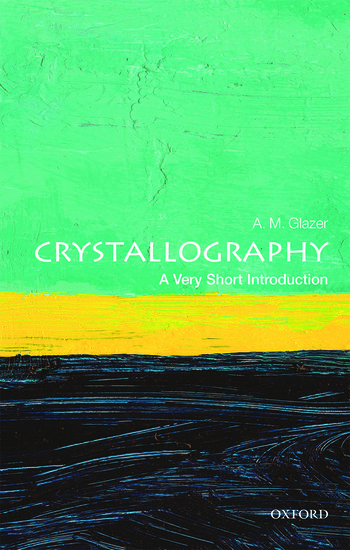Home >
A Very Short Introduction >
Crystallography (Geography)
A Very Short Introduction | Geography
Crystallography
ISBN: 9780198717591
Series: A Very Short Introduction
Crystallography (Geography)
A Very Short Introduction Crystallography (Geography) Media > Books > Non-Fiction > Education Books Expect Delays of Up to 4 Weeks| Order Below |
ISBN
9780198717591 (10-digit ISBN: 0198717598)
- Description
- Key Features
- Series Description
- Table of Contents
- Introduces the field of crystallography, and explains its basic concepts
- Gives an outline of the historical development of crystallography, and its key role in the early days of molecular biology
- Describes recent advances, and the importance of crystallography in the modern world in areas such as genetics and pharmaceuticals
Crystals have fascinated us for centuries with their beauty and symmetry, and have often been invested with magical powers. The use of X-ray diffraction, first pioneered in 1912 by father and son William and Lawrence Bragg, enabled us to probe the structure of molecules, and heralded the scientific study of crystals, leading to an understanding of their atomic arrangements at a fundamental level. The new discipline, called X-ray crystallography, has subsequently evolved into a formidable science that underpins many other scientific areas. Starting from the determination of the structures of very simple crystals, such as that of common salt, today it has become almost routine to determine the positions of tens of thousands of atoms in a crystal. In this Very Short Introduction Mike Glazer shows how the discoveries in crystallography have been applied to the creation of new and important materials, to drugs and pharmaceuticals and to our understanding of genetics, cell biology, proteins, and viruses. Tracing the history of crystallography, he analyses astonishing developments in new sources of X-rays, as well as of neutrons, and in electron microscopy, and considers the impact they have on the study of crystals today.
Oxford's Very Short Introductions series offers concise and original introductions to a wide range of subjects--from Islam to Sociology, Politics to Classics, Literary Theory to History, and Archaeology to the Bible.
Not simply a textbook of definitions, each volume in this series provides trenchant and provocative--yet always balanced and complete--discussions of the central issues in a given discipline or field. Every Very Short Introduction gives a readable evolution of the subject in question, demonstrating how the subject has developed and how it has influenced society. Eventually, the series will encompass every major academic discipline, offering all students an accessible and abundant reference library.
Whatever the area of study that one deems important or appealing, whatever the topic that fascinates the general reader, the Very Short Introductions series has a handy and affordable guide that will likely prove indispensable.
Please note: As this series is not ELT material, these titles are not subject to discount.
Preface
A long history!
Symmetry
Crystal structures
Diffraction
Seeing atoms
Sources of radiation
Further Reading
Index
Crystals have fascinated us for centuries with their beauty and symmetry, and have often been invested with magical powers. The use of X-ray diffraction, first pioneered in 1912 by father and son William and Lawrence Bragg, enabled us to probe the structure of molecules, and heralded the scientific study of crystals, leading to an understanding of their atomic arrangements at a fundamental level. The new discipline, called X-ray crystallography, has subsequently evolved into a formidable science that underpins many other scientific areas. Starting from the determination of the structures of very simple crystals, such as that of common salt, today it has become almost routine to determine the positions of tens of thousands of atoms in a crystal. In this Very Short Introduction Mike Glazer shows how the discoveries in crystallography have been applied to the creation of new and important materials, to drugs and pharmaceuticals and to our understanding of genetics, cell biology, proteins, and viruses. Tracing the history of crystallography, he analyses astonishing developments in new sources of X-rays, as well as of neutrons, and in electron microscopy, and considers the impact they have on the study of crystals today.
Key Features
- Introduces the field of crystallography, and explains its basic concepts
- Gives an outline of the historical development of crystallography, and its key role in the early days of molecular biology
- Describes recent advances, and the importance of crystallography in the modern world in areas such as genetics and pharmaceuticals
Series Description
Oxford's Very Short Introductions series offers concise and original introductions to a wide range of subjects--from Islam to Sociology, Politics to Classics, Literary Theory to History, and Archaeology to the Bible.
Not simply a textbook of definitions, each volume in this series provides trenchant and provocative--yet always balanced and complete--discussions of the central issues in a given discipline or field. Every Very Short Introduction gives a readable evolution of the subject in question, demonstrating how the subject has developed and how it has influenced society. Eventually, the series will encompass every major academic discipline, offering all students an accessible and abundant reference library.
Whatever the area of study that one deems important or appealing, whatever the topic that fascinates the general reader, the Very Short Introductions series has a handy and affordable guide that will likely prove indispensable.
Please note: As this series is not ELT material, these titles are not subject to discount.
EASY ORDER FORM
PRICES LISTED INCLUDE CONSUMPTION TAX
Price Before Tax:
¥1,790


